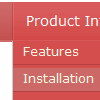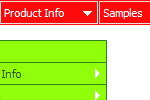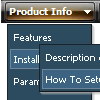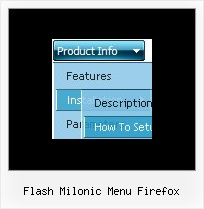Recent Questions
Q: I have created a menu for a product tutorial. It consists of about 50 topics, each of which is listed in my menu. I’m wondering if there is a way to gray out the menu link for the open tutorial topic?
A: Unfortunately, Deluxe Menu doesn't have such a feature.
You should write your own code, for example, on PHP.
You can try to use the following function
function disable() {
dm_ext_changeItem(1, 1, 1, ["", "", "", "", "", "_"]);
}
to disable your items.
The example you can find on our site
http://www.deluxe-menu.com/dynamic-functions-sample.html
Please, see the source code.
Q: I'm trying out your cool dropdown menu code.
I'm trying to rebuild my menu like this one
http://deluxe-menu.com/data-templates/vista-style-3-03-template-sample.html
I have a problem. In my case, I have some really long labels and some short ones. In some cases my text is larger than the button (see attachment). In your example all the buttons have the same width. Is it possible to have a Vista styled menu with different width for the buttons?
A: See images in Vista Templates have the fixed width and height (92 x 21).
If you want to change items' width/height you should change images.
btn_cyan.gif
btn_cyan2.gif
You can do it in any graph editor, for example in Adobe PhotoShop.
You should also change items width in your Individual Item Style.
var itemStyles = [
["itemWidth=92px","itemBorderWidth=0","fontStyle=normal 11pxTahoma","fontColor=#FFFFFF,#FFFFFF","itemBackImage=btn_cyan.gif,btn_cyan2.gif"],
];
You can do it in Deluxe Tuner.
Q: We have several problems with your menu.
Notice when trying to select a drop down item…the item disappears, rather than holding in place as the mouse is over the menu item.
Second, we’d like to know how to expand the width of the main headers and sub headers. Currently, they are not of the same width.
Lastly, we’d like to change the font and load new fonts to match the branding of the menu items.
Please let us know where we can find instructions to make these modifications/customizations.
A: Please, try to write your menuItems parameter correctly.
You should set "iconOver" parameter for each item (you can set "").
Please, see how you should write your menuItems:
["","index.php","nav_home_out.gif","nav_home_over.gif","","_self","0",,,],
["","","nav_experience_out.gif","nav_experience_over.gif","","_self","0",,,],
["|Contestants","experience_contestants.php","","","_self","2",,,],
...
> Second, we’d like to know how to expand the width of the
> main headers and sub headers. Currently, they are not of the
> same width.
You should use Individual styles, for example:
var itemStyles = [
["itemWidth=120px","arrowImageMain=image1,image2=home_out.gif,home_over.gif"], // style 0
["itemBorderWidth=2","itemBorderStyle=solid,solid", "itemBorderColor=#AA0000,#0000FF"], // style 1
["fontStyle=bold 12px Arial,Helvetica", "fontDecoration=none,underline"], // style 2
];
var menuItems = [
["","index.php","nav_home_out.gif","nav_home_over.gif","","_self","0",,,],
["","","nav_experience_out.gif","nav_experience_over.gif","","_self","0",,,],
...
For submenus you should set the following parameter:
var smWidth="150px";
> Lastly, we’d like to change the font and load new
> fonts to match the branding of the menu items.
You should also use Individual styles.
But you should set this parameter:
var fontStyle="";
And then use different fonts for your items.
Q: Will all your dhtml menu samples work cross-frame?
A: See how should you create cross frame menu:
1. To initialize the cross frame menu call dm_initFrame()
function instead of standard dm_init() function within data.js file:
dm_initFrame(framesetID, mainFrameInd, subFrameInd, orientation);
framesetID - id attribute of the frameset;
mainFrameInd - index of the main frame (where the top-menu is placed), >=0;
subFrameInd - index of the subframe (where the submenus will be shown), >=0;
orientation - frame orientaion: 0 - top-to-bottom, 1 - left-to-right; 2 - bottom-to-top; 3 - right-to-left.
So you should create your menu in Deluxe Tuner, save it.
Create html file with your frame set.
Set ID for the first frameset:
<FRAMESET id=frmSet rows=220,*>
<FRAME id=frame1 src="Deluxe Menu Samples_files/cross-frame-horizontal-1.htm"> //menu frame
<FRAME id=frame2 name=frame2 src="Deluxe Menu Samples_files/testlink.htm"> //content frame
</FRAMESET>
Then you should open your data file in any text editor and change
dm_init(); for example to dm_initFrame("frmSet", 0, 1, 0);
You'll find more info here:
http://deluxe-menu.com/cross-frame-mode-sample.html
 Home
Home Order Now!
Order Now!
 Contact Us
Contact Us








